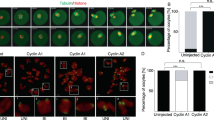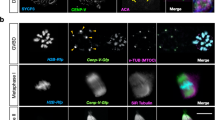Abstract
The C-mos proto-oncogene product, pp39mos, is present in unfertilized Xenopus eggs, and disappears on fertilization. Microinjection of synthetic mos RNA into two-cell embryos induces cleavage arrest at metaphase. By contrast, egg cytosol extracts, when immunodepleted of endogenous pp39mos, lose their cleavage-arresting activity in injected embryos. These results demonstrate that Mos protein is the cytostatic factor CSF, long known as an endogenous meiotic inhibitor in vertebrate eggs.
This is a preview of subscription content, access via your institution
Access options
Subscribe to this journal
Receive 51 print issues and online access
$199.00 per year
only $3.90 per issue
Buy this article
- Purchase on Springer Link
- Instant access to full article PDF
Prices may be subject to local taxes which are calculated during checkout
Similar content being viewed by others
References
Masui, Y. & Clarke, H. J. Int. Rev. Cytol. 57, 185–282 (1979).
Masui, Y. & Markert, C. J. exp. Zool. 177, 129–146 (1971).
Smith, L. D. & Ecker, R. E. Devl. Biol. 25, 233–247 (1971).
Kishimoto, T. Dev. Growth Different. 30, 105–115 (1988).
Ford, C. C. J. Embryol. exp. Morph. 89, 271–284 (1985).
Dunphy, W. G. & Newport, J. W. J. Cell Biol. 106, 2047–2056 (1988).
Lohka, M. J., Hayes, M. K. & Maller, J. L. Proc. natn. Acad Sci. U.S.A. 85, 3009–3013 (1988).
Dunphy, W. G., Brizuela, L., Beach, D. & Newport, J. Cell 54, 423–431 (1988).
Gautier, J., Norbury, C., Lohka, M., Nurse, P. & Mailer, J. Cell 54, 433–439 (1988).
Draetta, G. et al. Cell 56, 829–838 (1989).
Westendorf, J., Swenson, K. & Ruderman, J. J. Cell Biol. 108, 1431–1444 (1989).
Meijer, L. et al. EMBO J. 8, 2275–2282 (1989).
Masui, Y. in Biology of Fertilization vol. 1 (eds Metz, C. B. & Monroy, A.) 189–219 (Academic, New York, 1985).
Lillie, F. R. J. exp. Zool. 12, 427–476 (1912).
Brachet, J. Chemical Embryology (Wiley, New York, 1951).
Monroy, A. Chemistry and Physiology of Fertilization (Holt, Rinehart and Winston, New York, 1965).
Meyerhof, P. G. & Masui, Y. Devl. Biol. 61, 214–229 (1977).
Meyerhof, P. G. & Masui, Y. Devl. Biol. 72, 182–187 (1979).
Shibuya, E. K. & Masui, Y. Devl. Biol. 129, 253–264 (1988).
Masui, Y. & Shibuya, E. K. in Molecular Regulation of Nuclear Events in Mitosis and Meiosis (eds Schlegel, R. A., Halleck, M. S. & Rao, P. N.) 1–42 (Academic, Florida, 1987).
Gerhart, J. C., Wu, M. & Kirschner, M. W. J. Cell Biol. 98, 1247–1255 (1984).
Newport, J. W. & Kirschner, M. W. Cell 37, 731–742 (1984).
Murray, A. W., Solomon, M. J. & Kirschner, M. W. Nature 339, 280–286 (1989).
Maxwell, S. A. & Arlinghaus, R. B. Virology 143, 321–333 (1985).
Propst F. & Vande Woude, G. F. Nature 315, 516–518 (1985).
Goldman, D. S., Kiessling, A. A., Millette, C. F. & Cooper, G. M. Proc. natn. Acad. Sci. U.S.A. 84, 4509–4513 (1987).
Mutter, G. L. & Wolgemuth, D. L. Proc. natn. Acad. Sci. U.S.A. 84, 5301–5305 (1987).
Keshet, E. et al. Oncogene 2, 235–240 (1988).
Sagata, N., Oskarsson, M., Copeland, T., Brumbaugh, J. & Vande Woude, G. F. Nature 335, 519–525 (1988).
Sagata, N., Daar, I., Oskarsson, M., Showalter, S. & Vande Woude, G. F. Science 245, 643–646 (1989).
Paules, R. S., Buccione, R., Moschel, R. C., Vande Woude, G. F. & Eppig, J. J. Proc. natn. Acad. Sci. U.S.A. 86, 5395–5399 (1989).
Watanabe, N., Vande Woude, G. F., Ikawa, Y. & Sagata, N. Nature 342, 505–511 (1989).
Hannink, M. & Donoghue, D. J. Proc. natn. Acad. Sci. U.S.A. 82, 7894–7898 (1985).
Wasserman, W. J. & Masui, Y. Exp. Cell Res. 91, 381–388 (1975).
Murray, A. W. & Kirschner, M. W. Nature 339, 275–280 (1989).
Schmidt, M. et al. Molec. cell. Biol. 8, 923–929 (1988).
Paules, R. S. et al. Oncogene 3, 59–68 (1988).
Seth, A. & Vande Woude, G. F. in The Oncogene Handbook (eds Reddy, E. P., Skalka, A. M. & Curran, T. ) 195–211 (Elsevier, Amsterdam, 1988).
Papkoff, J., Verma, I. M. & Hunter, T. Cell 29, 417–426 (1982).
Graham, C. F. & Morgan, R. W. Devl. Biol. 14, 439–460 (1966).
Watson, R., Oskarsson, M. & Vande Woude, G. F. Proc. natn. Acad. Sci. U.S.A. 79, 4078–4082 (1982).
van der Hoorn, F. A., Hulsebos, E., Berns, A. J. M. & Bloemers, H. P. J. EMBO J. 1, 1313–1317 (1982).
Oskarsson, M., McClements, W., Blair, D. G., Maizel, J. V. & Vande Woude, G. F. Science 207, 1222–1224 (1980).
Balakier, H. & Czolowska, R. Exp. Cell Res. 110, 466–469 (1977).
Minshull, J., Blow J. J. & Hunt, T. Cell 56, 947–956 (1989).
Lehner, C. F. & O'Farrel, P. H. Cell 56, 957–968 (1989).
Dumont, J. N. J. Morphol. 136, 153–180 (1972).
Sagata, N., Shiokawa, K. & Yamana, K. Devl Biol. 77, 431–448 (1980).
Nieuwkoop, P. D. & Faber, J. Normal Table of Xenopus laevis Daudin (North-Holland Amsterdam, 1956).
Kawasaki, E. S. Nucleic Acids Res. 13, 4991–5004 (1985).
Krieg, P. A. & Melton, D. A. Nucleic Acids Res. 12, 7057–7070 (1984).
Rebagliati, M. R., Weeks, D. L., Harvey, R. P. & Melton, D. A. Cell 42, 769–777 (1985).
Author information
Authors and Affiliations
Rights and permissions
About this article
Cite this article
Sagata, N., Watanabe, N., Vande Woude, G. et al. The c-mos proto-oncogene product is a cytostatic factor responsible for meiotic arrest in vertebrate eggs. Nature 342, 512–518 (1989). https://doi.org/10.1038/342512a0
Received:
Accepted:
Issue Date:
DOI: https://doi.org/10.1038/342512a0
This article is cited by
-
Novel technique for definite blastomere inhibition and distribution of maternal RNA in sterlet Acipenser ruthenus embryo
Fisheries Science (2021)
-
Two-Step Mechanism of Cyclin B Degradation Initiated by Proteolytic Cleavage with the 26 S Proteasome in Fish
Scientific Reports (2020)
-
DNA methylation and miRNA-1296 act in concert to mediate spatiotemporal expression of KPNA7 during bovine oocyte and early embryonic development
BMC Developmental Biology (2019)
-
Emi2 mediates meiotic MII arrest by competitively inhibiting the binding of Ube2S to the APC/C
Nature Communications (2014)
-
Modulation of cell cycle control during oocyte-to-embryo transitions
The EMBO Journal (2013)
Comments
By submitting a comment you agree to abide by our Terms and Community Guidelines. If you find something abusive or that does not comply with our terms or guidelines please flag it as inappropriate.



